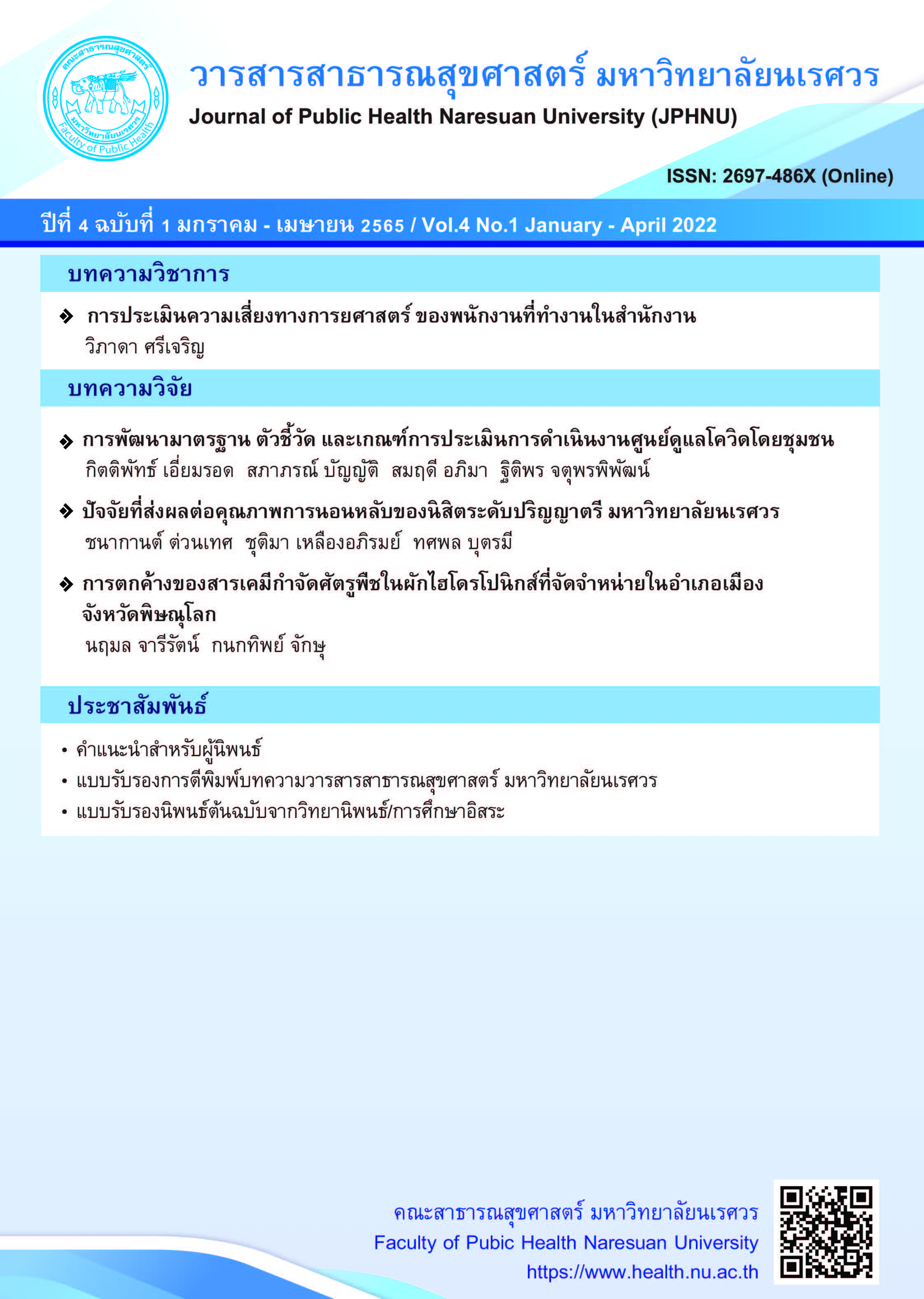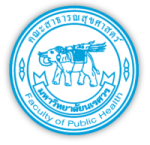Ergonomic risk assessment of employee in the office
Keywords:
Ergonomic Risk Assessment, Ergonomic, Working posture, OfficeAbstract
Office work has the nature of work that leads to an impact on health. The static working posture for many hours, physical inactivity, and an inappropriate working environment may put the employees at risk of work-related musculoskeletal disorders. Ergonomic risk assessment is the measure of the risk factors that may lead to musculoskeletal disorders in the employee's work environment, it is considered as the primary disease prevention. Currently, the use of office equipment such as working with computers with inappropriate ergonomic postures increased one of the risks of musculoskeletal disorders.
This article presents information related to ergonomic risk assessment, working posture in the office, ergonomic risk assessment tools, the example of research that applies ergonomics risk assessment tools for the office work, and the benefits of improving ergonomics in the office for the employees. The safety officer can use this information in conducting an ergonomic risk assessment and selecting the tools to assess and design the appropriate activity to achieve the safety environment in the office that will be minimize the risk for work-related musculoskeletal disorders among employees.
References
Alavi, S. S., Abbasi, M., & Mehrdad, R. (2016). Risk factors for upper extremity musculoskeletal disorders among office workers in Qom Province, Iran. Iranian Red Crescent Medical Journal, 8(10), 1-8.
Butmee, T. (2016). Ergonomics risk assessment tools. Disease Control Journal, 41(1), 11-14. (in Thai)
Chaiklieng, S., & Poochada, W. (2016). The effectiveness of ergonomics implemented program among call center workers. Srinagarind Medical Journal, 31(5), 325-331. (in Thai)
Chaiklieng, S., Suggaravetsiri, P., & Stewart, J. (2021). Incidence and risk factors associated with lower back pain among university office workers. International Journal of Occupational Safety and Ergonomics, 27(4), 1215-1221.
Chaothaworn, C., Chanprasit, C., & Jongrungrotsakul, W. (2014). Health status related to risk at work among shallot farmers, Cham Pa Wai Subdistrict, Mueang District, Phayao Province. Nursing Journal, 41(2), 35-47. (in Thai)
Chuntum, K. (2015). Prevalence and risk factor for musculoskeletal disorders among Chaiyaphum Rajabhat University workers. Journal of Nursing and Health Sciences, 9(3), 166-178. (in Thai)
Clarkson, H. M. (2013). Musculoskeletal assessment: Joint motion and muscle testing.(3rd ed.). Philadelphia: Lippincott Williams & Wilkins.
Collier, J., Hernandez, J., Patel, K., Luyindula, E. S., Eskew, P., Kozunov, I., et al. (2019). How to Perform an Ergonomic Assessment in the Workplace. Retrieved February1, 2022, fromhttps://proactive-md.com/how-to-performan-ergonomic-assessment-in-the-workplace/
Dawongsa, P. (2015). Cumulative trauma disorder. EAU Heritage Journal Social Science and Humanities, 9(1), 33-38. (in Thai)
Department of Disease Control. (2019). Report of diseases and health hazards from occupational and environment 2018: The age group with the most cases of musculoskeletal disease. Retrieved February 1,2022, from http://envocc.ddc.moph.go.th/uploads/situation2/2561/2561_01_envocc_ situation.pdf (in Thai)
Ekburanawat, W., Chino, C., & Polbun, N. (2011). First step to occupational medicine. (3rd ed.). Chon Buri: Summacheeva Foundation. (in Thai)
Ergonomics Risk Assessment Standards Team. (2021). Ergonomic standard on risk assessment of static working posture. Bangkok: Thailand Institute of Occupational Safety and Health (Public Organization). (in Thai)
Etuknwa, A. B., & Humpheries, S. (2018). A systematic review on the effectiveness of ergonomic training intervention in reducing the risk of musculoskeletal disorder. Journal of Nursing and Health Studies, 3(2), 3. doi: 10.21767/2574-2825.1000032.
European Agency for Safety and Health at Work. (2007). Office ergonomics. Retrieved February 16, 2022, from https://osha.europa.eu/en/publications/e-fact-13-officeergonomics.
Habibi, E., Mohammadi, Z., & Sartang, A. G. (2016). Ergonomic assessment of musculoskeletal disorders risk among the computer users by Rapid Upper Limb Assessment method. International Journal of Environmental Engineering, 5(2), 1-4.
Health and Safety Executive. (2014). Health and safety statistics. Retrieved October 2, 2017, from http://www.hse.gov.uk/statistics/
Health and Safety Executive. (2015). Risk assessment: A brif guide to controlling risks in the workplace. Retrieved February 1, 2022, from http://www.hse.gov.uk/pubns/indg163.pdf.
Hodgins, M., Fleming, P., & Griffiths, J. (2016). Promoting health and well-being in the workplace: Beyond the statutory imperative. England: Published by Palgrave.
Jaibarn, P., Suthakorn, W., & Kaewthummanukul, T. (2013). Ergonomic factors and work-related musculoskeletal disorders among hospital supporting staffs working with computers. Nursing Journal, 40(Special),1-11. (in Thai)
Janwatanakul, P. (2015). Musculoskeletal disease in office workers from research to practice. (1st ed.). Bangkok: K. Pon (1996) Company Limited. (in Thai)
Keawnual, A., Lohapoontagoon, B., & Pochana, K. (2017). Prevalence of work-related musculoskeletal disorders in various occupations. The Public Health Journal of Burapha University, 12(2), 53-64. (in Thai)
Kingkaew, W. M. (2016). An analytical study of the impact caused by the myofascial pain syndrome:MPS. Journal of Allied Health Sciences SuanSunandha Rajabhat University, 1(1),12-29. (in Thai)
Kongdee, W. (2020). Situation of "Diseases" among working-age people "World". Retrieved February 1, 2022, from https://www.ohswa.or.th/17675458/health-promotion-for-jorporseries-ep2. (in Thai)
Kosidaphun, A., Samrong, A., & Sribroorapa, S. (2016). Effects of upper extremity disability on ergonomics risk and pain among computer user of office workers. Thailand national ergonomic conference (p. 1-15). Pathum Thani: Institute of East Asian Studies. (in Thai)
Krusun, M., & Chaiklieng, S. (2013). Ergonomic risk assessment in university office workers. KKU Research Journal, 19(5), 696-707. (in Thai)
Labour Market Research Division. (2018). Occupation trends 2015-2019. Retrieved February 15, 2022, from https://www.doe.go.th/prd/assets/upload/files/bkk_th/a8b1450c699bf90745de2cf8221447b6.pdf (in Thai)
Laokiat, L. (2017). Injuries abnormal and occupational disease: Prevention. Pathum Thani: Thammasat Printing house. (in Thai)
Mani, K. (2018). Ergonomics education for office computer workers: An evidence-based strategy. Retrieved February 8, 2022, from https://www.intechopen.com/chapters/57980.
Mahmud, N., Kenny, T. D., Zein, Md. R., & Hassan, N. S. (2011). Ergonomic training reduces musculoskeletal disorders among office workers: Result from 6 month follow up. Malaysian Journal Medical Science, 18(2), 16-26.
Meepradit, P. (2016). Ergonomics risk assessment. Bangkok: O. S. Printing House. (in Thai)
Mohammadipour, F., Pourranjbar, M., Naderi, S., & Rafie, F. (2018). Work-related musculoskeletal disorders in Iranian office workers: Prevalence and risk factors. International Journal of Musculoskeletal Pain Prevention, 2(3), 293-298.
National Statistical Office. (2021). Whole kingdom Quarter 3: July-September 2021. Bangkok: Statistical Forecasting Division, National Statistical Office. (in Thai)
Niu, S. (2010). Ergonomics and occupational safety and health: An ILO perspective. Applied Ergonomics, 41(6), 744-753.
Noroozi, M. V., Hajibabaei, M., Saki, A., & Memari, Z. (2015). Prevalence of musculoskeletal disorders among office workers. Jundishapur Journal of Health Sciences, 7(1), 1-5.
Phonharn, N., Ruengvoraboon, S., Boonkaew, K., & Seewirat, A. (2014). The physical symtoms that occur from using computer of supporting staffs of Nakhon Phanom University. Srinakharinwirot University Journal of Science and Technology, 6(12), 26-38. (in Thai)
Poochada, W., & Chaiklieng, S. (2015). Prevalence and discomfort characteristics of neck, shoulder and backpainamong call center workers in KhonKaen Province. Srinagarind Medical Journal, 30(4), 369-376. (in Thai)
Social Security Office, Thailand e-Goverment. (2018). Experience situation Hazard or illness due to work 2013-2017. Retrieved February 1, 2022, from https://www.sso.go.th/wpr/assets/upload/files_storage/sso_th/fe4bf98524ca20d6768e7ded43dabb4d.pdf. (in Thai)
Sukhothai Thammathirat Open University. (2012). Ergonomics Chapter 1-15.(3rd ed.). Bangkok: Sukhothai Thammathirat Open University. (in Thai)
Suriya, T., Rattnakool, T., & Sukkrajang, K. (2015). Assessment of safety behavior of computer usersoffice. Case study of Faculty of Industrial Technology, Songkhla Rajabhat University. Proceedings Report on the 6th Hatyai National Conference (p. 1442-1453). Songkhla: Hatyai University. (in Thai)
Tantipanjaporn, T., Yoonim, Y., Tongmee, Y., & Keeratisiroj, O. (2019). The effect of computer using workload on work-related upper extremity, neck and back musculoskeletal disorders among office workers. Srinagarind Medical Journal, 34(1),60-67. (in Thai)
Taweepiriyajinda, S. (2015). Hazadous working posture among non-healthcare workers of Naradhiwasrajanakarindra hospital and prevalence of work-related musculoskeletal disorders (WMSDs). KKU Research Journal, 15(2), 80-88. (in Thai)
Thailand Institute of Occupational Safety and Health (Public Organization). (2019). Ergonomics Standard on Working with Computer (SHS301: 2018). Bankok: Thailand Institute of Occupational Safety and Health (Public Organization). (in Thai)
Vinyoocharoenkul, J., & Pochana, K. (2015). The ergonomic risk assessment of computer user by Rapid Office Strain Assessment (ROSA) Method. Journal of Public Health, 45(2), 148-158. (in Thai)
Working groups on Ergonomics Manual for Computer Operations Improvement in the Office. (2019). Ergonomics manual for computer operations improvement in the office. Bangkok: Chayakorn Printing Company Limited. (in Thai)
Yoopat, P. (2018). Ergonomics and work physiology. Pathum Thani: Rangsit University Publishing House. (in Thai)
Downloads
Published
How to Cite
Issue
Section
License
Copyright (c) 2022 Journal of Public Health Naresuan University

This work is licensed under a Creative Commons Attribution-NonCommercial-NoDerivatives 4.0 International License.
The published article is copyrighted by the Journal of Public Health and Health Sciences Research.
The statements that appear in each article in this academic and research journal are the personal opinions of each author and are not related to Naresuan University and other faculty members in the university. Responsibilities regarding each article are the responsibility of each author.






